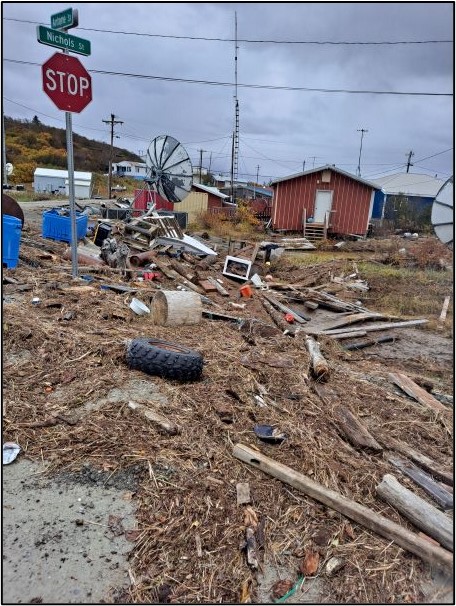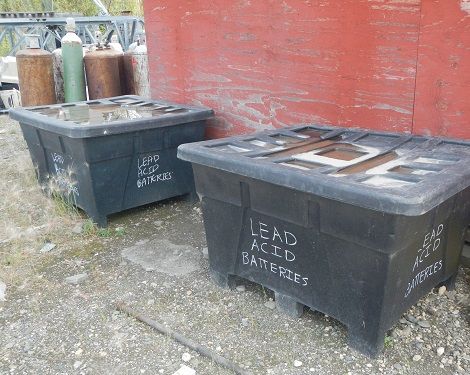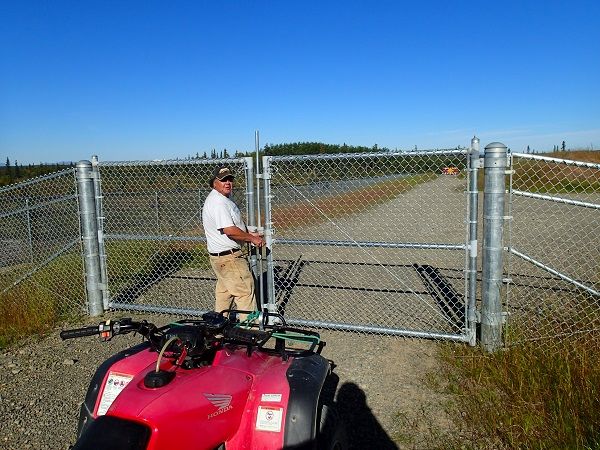Minimize Flooding Impacts

Previous floods in communities have caused major problems not only to the landfill (large amounts of debris to dispose of) but also to waste being stored within the community.
Flooding is becoming more common with increasing climate change. Breakup can happen multiple times in a season and catch your community (and landfill) unprepared.
You can monitor breakup conditions by the National Weather Service at these sites:
- NWS: River Forecast Center - Breakup map (top) and water prediction map (bottom)
- NWS: Flood Warnings, Watches, Statements
Short-term Planning for Waste
If your landfill is already located on high ground and most of your materials are staged there, you only need to focus on materials that are still within the floodplain. We’ve identified 7 Priority Actions below that you can do to ensure your community’s current waste and recycling system is secure and doesn’t contribute to flooding issues. (Priority Actions Print version)
Long-term Planning for Disaster Debris
All communities should have a suitable location already approved for disaster debris, and a plan for how debris will be managed after a disaster. During and after a disaster is a high stress and tiring time for everyone, which is why it is so critical to have completed this planning in advance. Having a debris management plan will also assist volunteer agencies or military who are deployed to your community with managing debris in your community correctly. Now is the time to determine where an emergency debris landfill could be located. It would not replace the local landfill, but it would be specifically for one-time disaster debris.
If you have any questions regarding these recommendations, or would like to discuss what your community could do in the event of a flood, please contact your Rural Landfill Specialist.

Seven Priority Actions to Complete Immediately
- Remove any materials staged for backhaul from the barge landing and:
- Good: Secure using banding or cargo straps and store away from the river.
- Better: Store them in a building or connex box that is secured to the ground.
- Best: Move them to high ground.
- Secure any loose items that will easily float, such as freezers, refrigerators, etc. if they are stored in the flood plain and:
- Good: Store inside the landfill and close the gate.
- Best: Move to high ground.
- Ensure that all liquids, chemicals, containers, and drums containing hazardous substances including fuels, oils, antifreeze, and any other liquids are:
- Good: Properly labeled and have leak-proof secured lids in place.
- Better: Stored with leak-proof lids inside a building or secured connex.
- Best: Moved to high ground.
- Secure and relocate any lead-acid batteries:
- Good: In a tote with a lid secured in place.
- Better: In a tote with a secured lid in a connex or building.
- Best: In a secured and covered container or tote and moved to higher ground.
- Lock and secure any connex or other containers that may contain collected recycling such as aluminum cans or plastic bottles. This can be done by:
- Good: Using a cargo strap on the doors and securely staking the connex into the ground.
- Better: Chaining the connex to a large heavy object such as a piece of heavy equipment.
- Best: Moving the connex to higher ground.
- If possible, cover all disposed wastes at the landfill with cover material. Covered waste is less likely to wash out of the landfill in the event of a flood.
- Good: Consolidate waste and use what cover material is available.
- Best: Consolidate waste and cover with at least 6 inches of material.
- Close and secure the landfill gate and any other open points to the landfill. This may help contain wastes within the landfill boundary during a flood.

- Good: Use a temporary fence such as snow or silt fencing to close up landfill.
- Better: Use a chain-link swing gate that reaches the ground to close up landfill.
- Best: Use a chain-link swing gate that reaches the ground to close up landfill. Also fill in any gaps between the ground and the fence line to fully enclose the landfill.

 Indicates an external site.
Indicates an external site.